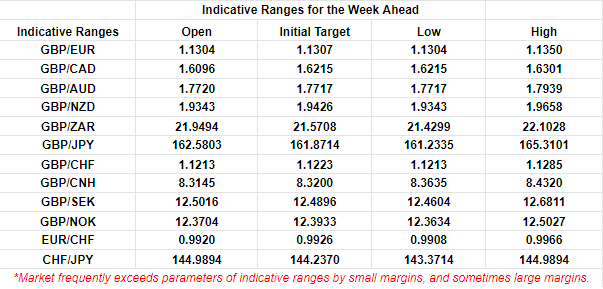EUR/USD Week Ahead Forecast: North American Headwinds Obstruct Recovery
- EUR/USD seeks support at 1.0535 but risks more losses
- Scope for support near to 1.0461 & 1.0407 further down
- Lingering upside risks for ECB rate outlook still underpin
- U.S. economy resilience, inflation & Fed risks constrain

The Euro to Dollar exchange rate entered the new week looking for a foothold near 2023 lows but at risk of a deeper corrective setback following broad gains for the greenback, which could be likely to keep many currency counterparts on the defensive in the days ahead.
Europe's single currency came under pressure last week as the Dollar extended recent gains almost across the board in response to fresh signs that U.S. inflation risks remain squarely on the upside, which has acted as a further tailwind for market-implied expectations of the Fed Funds rate.
The Euro still held up better than many other currencies, however, and another downward revision to official estimates of German GDP in the final quarter was not enough to deter its resilience on Friday but it still remains to be seen if EUR/USD can weather the event risks lurking in this week's calendar.
"The FX market is slowly pricing in the realization that inflationary pressures in the Western industrialized countries (here: the U.S. and the euro area) are more persistent than market participants had previously suspected," says Ulrich Leuchtmann, head of FX research at Commerzbank.
"This is USD-positive because the Fed is seen as more "proactive" compared to the ECB. EUR-USD levels around 1.10 have therefore not (yet) proven sustainable," Leuchtmann writes in a Friday review of forecasts suggesting EUR/USD could struggle to sustain itself above 1.06 in the months ahead.
Above: Euro to Dollar rate shown at daily intervals with Fibonacci retracements of various microtrends indicating possible areas of technical support. Click image for closer inspection.
Dollars were bought across the board on Friday with momentum picking up pace after the Bureau of Economic Analysis said the Core Personal Consumption Expenditures (PCE) Price Index inflation rate had risen by 0.6% in January, up from 0.4% previously.
Friday's increase for January from what is the preferred measure of inflation at the Federal Reserve (Fed) comes in the wake of other figures suggesting that price pressures began building within corporate supply chains again in the new year and keeps the market focused on upside risks to the Fed Funds rate.
"A strong PCE report points to upside risks to the Fed's terminal expectations. With US-centric risks at the fore, the USD is likely to retain a tactical advantage on a broad basis until proven otherwise," says a regular daily briefing from the TD Securities FX research desk.
This is especially so when recent price figures are combined with the other generally resilient economic data coming from the U.S., which has boosted the U.S. Dollar in recent trade and could potentially continue to have adverse implications for EUR/USD in the days ahead.
"We are maintaining our short EUR/USD trade idea. The pair has broken back below the 1.06000-level over the past week and we expect it to fall back towards support from the 200-day moving average that comes in at around 1.0330," says Lee Hardman, a senior currency analyst at MUFG.
"The move higher in US yields has been bigger than in the euro. The price action also highlights that the euro-zone rate market and euro have already moved a long way at the start of this year to better reflect a better-than-expected cyclical outlook in the euro-zone," he adds in a Friday market commentary.
While many analysts retain a cautious outlook for the Euro to Dollar rate, there would be upside risk this week if Thursday's February inflation figures go the wrong way for European Central Bank (ECB) policymakers hoping to see price growth returning to levels more consistent with the 2% target.
Above: Financial model-derived estimates of probable trading ranges for selected currency pairs this week. Source Pound Sterling Live. (If you are looking to protect or boost your international payment budget you could consider securing today's rate for use in the future, or set an order for your ideal rate when it is achieved, more information can be found here.)
The consensus among economists suggests European inflation edged lower from 8.6% to 8.4% in February but remained unchanged at 5.3% when energy and food items are removed from the goods basket for which prices are analysed.
An unchanged core reading would potentially keep upside risks to ECB interest rate expectations alive and support the Euro but much about this week will also depend this week on the outcome and implications of multiple U.S. event risks.
These begin with Monday's release core durable goods orders data for January in the U.S. and a noon speech from Federal Reserve Board Governor Philip Jefferson covering "recent inflation and the dual mandate," before moving on to January trade balance and February consumer confidence figures.
"The ECB has locked in a 50bp hike at the next meeting on 16 March. In our view, market pricing for the May meeting can be influenced by this week’s CPI. The OIS market is pricing 45bp of tightening for the May meeting," says Joseph Capurso, head of international economics at Commonwealth Bank of Australia.
"EUR/USD faces support at 1.0320 (200 day moving average). AUD/EUR can ease if the Eurozone’score CPI shows no signs of cooling. The next level of downside support is the 0.6259 (0% Fibbo)," Capurso and colleagues write in a Monday research briefing.
 Above: Euro to Dollar rate shown at weekly intervals with selected moving averages denoting possible areas of technical resistance. Click image for closer inspection.
Above: Euro to Dollar rate shown at weekly intervals with selected moving averages denoting possible areas of technical resistance. Click image for closer inspection.


